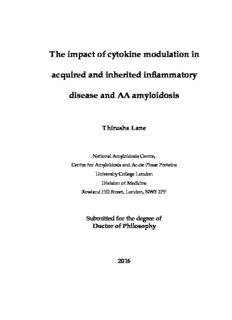
The impact of cytokine modulation in acquired and inherited inflammatory disease and AA ... PDF
Preview The impact of cytokine modulation in acquired and inherited inflammatory disease and AA ...
The impact of cytokine modulation in acquired and inherited inflammatory disease and AA amyloidosis Thirusha Lane National Amyloidosis Centre, Centre for Amyloidosis and Acute Phase Proteins University College London Division of Medicine Rowland Hill Street, London, NW3 2PF Submitted for the degree of Doctor of Philosophy 2016 Declaration I, Thirusha Lane, confirm that the work presented in this thesis is my own. Where informationhasbeenderivedfromothersources,thishasbeendeclaredwithinthethesis. Signature: (Electronicallysigned) Date: 11th May 2016 2|Pag e Abstract Background Inflammatory disorders(IDs)cause significantmorbidity. SAA andCRPareacute phase proteinsusedtodiagnoseandmonitorIDs.SAAisalsotheprecursortoAAamyloidosis (AAA), a serious complication of chronic inflammation, causing renal failure and poor quality of life (QoL). The aim of treatment is thus to prevent AAA or to halt its progression to renal failure, protect renal allografts, and restore QoL. Novel biological therapies have transformed the landscape, but their longer term effects are yet to be elucidated. Aims Wesetupanurse-ledclinictoexploresafetyandefficacyofmodulationofcytokinesIL- 1 and IL-6 in patients with IDs and AAA, and studied the changing epidemiology of AAA. We alsosoughttoinvestigate whetherCRPwasitselfpro-inflammatory. Results SuppressingSAAusinganti-IL-1andanti-IL-6agentsresultedinstabilisationofamyloid depositsandinsome, amyloidregressionandimprovedrenal function. Treatmentswere safe and effective in dialysis and renal transplantation, even where the underlying cause of AAA was uncertain. Improvement was seen in almost all anti-IL-1-treated CAPS patients. Common adverse events were infections. QoL improved when treatment was effective. Referral rates of AAA have remained steady whilst other types have increased. ThecommonestcausesofAAAarechanging;unknownaetiologyhasincreased.Injection ofpurifiedCRPintovolunteersdidnotprovoke inflammation. 3|Pag e Conclusions Suppressing SAA by effectively treating the underlying ID can lead to improved renal function and regression of amyloid, even when the cause is uncertain. Anti-cytokine agentsofferthepossibilityoftargetedtherapiestosuppresssystemicinflammation.Work reported here shows safety, even in dialysis and transplantation. AAA is becoming less commonassomeIDshavebecomeeasiertocontrol.Singlecytokineblockadehasproved useful inAAA ofunknown aetiology andtreatmentgenerally improvessymptomatology andinflammation. CRPisitselfnotpro-inflammatory. 4|Pag e EthicalApproval IndependentResearchEthicsCommittee(REC)approvalwassoughtandreceivedforall clinical studies, including retrospective work. The applicable REC reference number is quotedineachchapter. 5|Pag e Acknowledgements Iwouldliketothankmysupervisors,ProfessorPhilipHawkinsandDrHelenLachmann. I am grateful to Professor Sir Mark Pepys for guidance. I would also like to thank the wonderfulstaffattheNationalAmyloidosisCentrefortheirsupportandencouragement, in particular, my colleagues Darren Foard, Lisa Rannigan and Rene Williams who supportedmeandheldthefortwhilstIwaswriting;andJeanBerkeleywhoassistedwith references. Iamgrateful tomy partnerDavidHuttforhis supportandpatience. I am grateful to the patients and healthy volunteers who took part in these studies and who consented to the analysis and publication of their data for the greater good. I am in awe of their sacrifices and contributions, and humbled by their trust, gratitude and support. Finally, I would like to acknowledge my parents, Pam and Flynn Nair, without whose innumerable silent sacrifices in my early life, I would not have been able to achieve this today. Thisthesisisdedicatedtothem. 6|Pag e Contents Declaration...................................................................................................................................2 Abstract.........................................................................................................................................3 Ethical Approval.........................................................................................................................5 Acknowledgements.....................................................................................................................6 Contents........................................................................................................................................7 ListofFigures............................................................................................................................12 Listof Tables.............................................................................................................................14 ChapterOne: Introduction......................................................................................................15 1.1 The Innate Immune System....................................................................................16 1.2 Autoinflammatory pathogenic mechanisms.........................................................17 1.2.1 The NLRP3 inflammasome............................................................................17 1.2.2 Otherplayersandmechanismsdriving inflammation................................18 1.3 Systemic Autoinflammatory Diseases.........................................................................24 1.3.1 Familial MediterraneanFever...............................................................................27 1.3.2 Cryopyrin-AssociatedPeriodic Syndrome..........................................................30 1.3.3 TumorNecrosisFactorReceptor-AssociatedPeriodic Syndrome.................31 1.3.4 Mevalonate KinaseDeficiency.............................................................................32 1.4 Amyloidosis.....................................................................................................................33 1.4.1 Precursorproteinsandfibrillogenesis.................................................................34 1.4.2 Non-fibrillarcomponents......................................................................................36 1.5 Systemic AAamyloidosis..............................................................................................36 1.6 HepaticAcute PhaseProteins......................................................................................38 1.6.1 C-Reactive Protein..................................................................................................39 1.6.2 SerumAmyloidA Protein.....................................................................................39 1.7 Diagnosing AAamyloidosis.........................................................................................40 1.7.1 Histology andimmunohistochemistry.................................................................40 1.7.2 SAPscintigraphy.....................................................................................................41 1.7.3 Otherinvestigations...............................................................................................41 1.8 Diagnosing systemic autoinflammatory syndromes..................................................42 1.9 Measuring quality oflife (QoL)....................................................................................42 1.10 The UKNational AmyloidosisCentre.....................................................................45 Aims............................................................................................................................................46 ChapterTwo: Methods............................................................................................................49 7|Pag e 2.1 Methodsperformedby the author..............................................................................50 2.1.1 Patientselectionandethical approval..................................................................50 2.1.2 CAPS/Inflammationnurse-ledclinic protocol..................................................50 2.1.3 Definitionofresponse totherapy inSAIDs......................................................51 2.1.4 AssessmentofCAPS disease activity...................................................................51 2.1.5 Venepuncture andinjectionofradio-iodinatedSAP........................................51 2.1.6 Quality oflifeassessments....................................................................................52 2.1.7 Statisticalanalysis....................................................................................................52 2.2 Methodsperformedorcontributedby others...........................................................53 2.2.1 Criteria fordiagnosisofamyloidosisanddefinitionoforganresponse.........53 2.2.2 Histology andimmunohistochemistry.................................................................54 2.2.3 Serumandplasmaassays.......................................................................................55 2.2.4 Geneticanalysis.......................................................................................................56 2.2.5 PurificationofhumanCRP...................................................................................56 2.2.6 SAPscintigraphy.....................................................................................................57 ChapterThree: EstablishmentofNurse-ledClinical andResearchServices...................59 3.1 Background.....................................................................................................................60 3.2 Aims.................................................................................................................................61 3.3 Patientsandmethods.....................................................................................................61 3.3.1 Patients, volunteersanddiagnosis........................................................................61 3.3.2 Administrationoftherapies..................................................................................61 3.3.3 Othermethods........................................................................................................62 3.4 Results..............................................................................................................................62 3.4.1 CAPS nurse clinic protocol...................................................................................62 3.4.2 Protocolsforothertherapies................................................................................65 3.5 Discussion.......................................................................................................................65 ChapterFour: CharacterisationofAA AmyloidosisComplicating Systemic Autoinflammatory Diseases.....................................................................................................67 4.1 Background.....................................................................................................................68 4.2 Aims.................................................................................................................................68 4.3 PatientsandMethods....................................................................................................68 4.3.1 Patientsanddiagnosis............................................................................................68 4.3.2 Othermethods........................................................................................................69 4.4 Results..............................................................................................................................69 4.4.1 Wholecohortcharacteristics.................................................................................69 4.4.2 FMFpatients...........................................................................................................72 4.4.3 TRAPS patients.......................................................................................................72 4.4.4 CAPS patients.........................................................................................................73 8|Pag e 4.4.5 MKDpatients.........................................................................................................73 4.4.6 Wholecohortrenal function.................................................................................76 4.4.7 Wholecohortsurvival............................................................................................76 4.5 Discussion.......................................................................................................................76 ChapterFive: Safety andEfficacy ofInhibitionofInterleukin-6 inChronic Inflammatory DiseasesandAutoinflammation....................................................................80 5.1 Background.....................................................................................................................81 5.2 Aims.................................................................................................................................83 5.3 Methods...........................................................................................................................83 5.3.1 Patients.....................................................................................................................83 5.3.2 Othermethods........................................................................................................84 5.4 Results..............................................................................................................................84 5.4.1 Wholecohortcharacteristics.................................................................................84 5.4.2 Serial monitoring ofthe acute phase response...................................................84 5.4.3 Change inrenal functioninAA amyloidcases..................................................85 5.4.4 Monitoring ofamyloiddeposits...........................................................................85 5.3.5 QoLbefore andaftertreatment...........................................................................87 5.3.6 Adverse events........................................................................................................87 5.4 Discussion.......................................................................................................................90 ChapterSix: Safety andEfficacy ofInhibitionofInterleukin-1 inInflammatory DisordersandAA Amyloidosis..............................................................................................95 ChapterSix PartI: Interleukin-1 InhibitioninCryopyrin-AssociatedPeriodic Syndrome –A 13-Year, Single-Centre Experience ofSafetyandEfficacy.........................................98 6.1.1 Background..................................................................................................................99 6.1.2. Aims...........................................................................................................................100 6.1.3 PatientsandMethods...............................................................................................100 6.1.3.1 Patientsandassessments..................................................................................100 6.1.3.2 Othermethods...................................................................................................101 6.1.4 Results.........................................................................................................................101 6.1.4.1 Whole cohortcharacteristics............................................................................101 6.1.4.2 General characteristicsofthe analysiscohort...............................................102 6.1.4.3 Clinicalcharacteristicsofthe analysiscohort................................................106 6.1.4.4 Efficacy ofanti-IL-1 therapy...........................................................................107 6.1.4.5 Non-respondersorinadequate responders...................................................111 6.1.4.6. Breakthroughsymptoms.................................................................................115 6.1.4.7 Quality oflife.....................................................................................................116 6.1.4.8 Safety...................................................................................................................122 6.1.5 Discussion..................................................................................................................122 9|Pag e ChapterSix PartII: SafetyandEfficacy ofEmpiricalInterleukin-1 InhibitioninAA AmyloidosisofUncertainAetiology....................................................................................126 6.2.1 Background................................................................................................................127 6.2.2 Aims............................................................................................................................128 6.2.3 PatientsandMethods...............................................................................................128 6.2.3.1 Patients................................................................................................................128 6.2.3.2 Othermethods...................................................................................................133 6.2.4 Results.........................................................................................................................133 6.2.4.1 Whole cohortcharacteristics............................................................................133 6.2.4.2 Response toanakinra........................................................................................133 6.2.4.3 Serial monitoring ofSAA.................................................................................133 6.2.4.4 Renal function....................................................................................................134 6.2.4.5 Monitoring ofamyloiddeposits......................................................................136 6.2.5 Discussion..................................................................................................................138 ChapterSeven: ChangingEpidemiology ofAA Amyloidosis–Clinical Observations Over25 Yearsata SingleNational Referral Centre...........................................................140 7.1 Background...................................................................................................................141 7.2 Aims...............................................................................................................................142 7.3 Patientsandmethods...................................................................................................142 7.3.1 Patients...................................................................................................................142 7.3.2 Diagnosis................................................................................................................142 7.3.3 Othermethods......................................................................................................142 7.4 Results............................................................................................................................143 7.4.1 Whole-cohortcharacteristics..............................................................................143 7.4.2 Comparisonofcohorts........................................................................................144 7.5 Discussion.....................................................................................................................148 ChapterEight: TheClassical Acute Phase Protein-The Non-Pathogenic RoleofSerum C-Reactive Protein..................................................................................................................150 8.1 Background...................................................................................................................151 8.2 Aims...............................................................................................................................152 8.3 SubjectsandMethods..................................................................................................152 8.3.1 Subjects..................................................................................................................152 8.3.2 Study investigationsandprocedures..................................................................152 8.3.3 Regulatory andEthical Aspects..........................................................................154 8.3.4 Othermethods......................................................................................................154 8.4 Results............................................................................................................................154 8.5 Discussion.....................................................................................................................160 ChapterNine: General Conclusions.....................................................................................163 10|Pag e
Description: